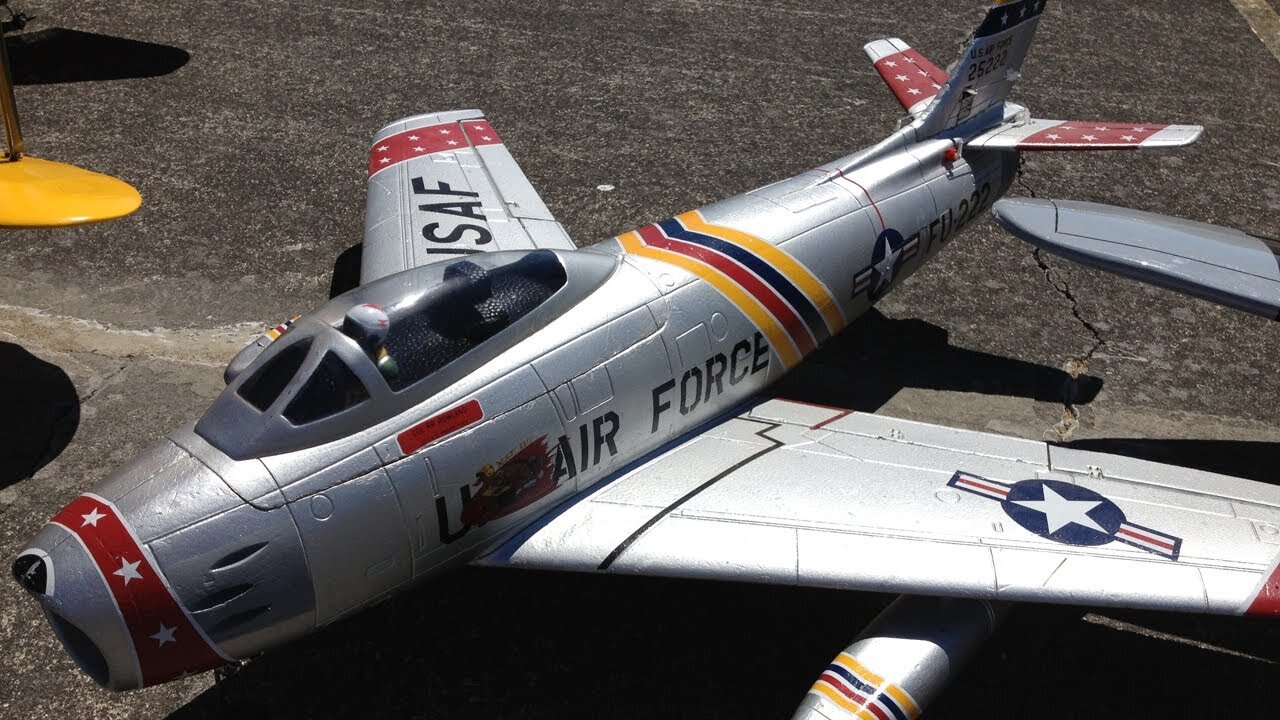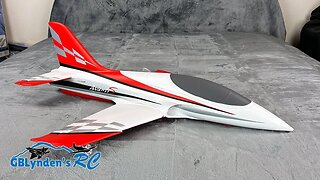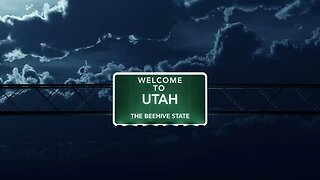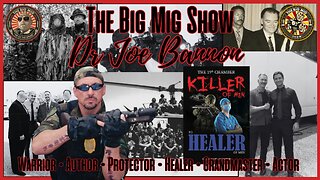Premium Only Content

F-86 Sabre EDF Jet at Warbirds Over Whatcom at Bell Air RC Club's Field
This is a quick video of a F-86 Sabre EDF jet Foamie at Warbirds Over Whatcom at Bell Air RC Club in Ferndale, WA, which is located in Whatcom County.
This is a nice jet and he flew it well, but didn't come in low much if at all or this video would be a lot more entertaining. It sure is a pretty little parkflyer foamy though!
After seeing this one fly, I may have to add this one to my hanger alongside my F/A-18 Super Hornet Blue Angel EDF Jet. Some people also refer to it simply as a F-18 Hornet.
F-86 Sabre History:
The North American F-86 Sabre (sometimes called the Sabrejet) was a transonic jet fighter aircraft. Produced by North American Aviation, the Sabre is best known as America's first swept wing fighter which could counter the similarly winged Soviet MiG-15 in high-speed dogfights over the skies of the Korean War. Considered one of the best and most important fighter aircraft in the Korean War, the F-86 is also rated highly in comparison with fighters of other eras.[3] Although it was developed in the late 1940s and was outdated by the end of the 1950s, the Sabre proved versatile and adaptable, and continued as a front-line fighter in numerous air forces until the last active operational examples were retired by the Bolivian Air Force in 1994.
Its success led to an extended production run of more than 7,800 aircraft between 1949 and 1956, in the United States, Japan and Italy. Variants were built in Canada and Australia. The Canadair Sabre added another 1,815 airframes, and the significantly redesigned CAC Sabre (sometimes known as the Avon Sabre or CAC CA-27), had a production run of 112. It was by far the most-produced Western jet fighter, with total production of all variants at 9,860 units.[1]
North American had produced the highly successful propeller-powered P-51 Mustang in World War II, which saw combat against some of the first operational jet fighters. By late 1944, North American proposed its first jet fighter to the U.S. Navy which became the FJ-1 Fury. It was an unexceptional transitional jet fighter which had a straight wing derived from the P-51.[4][5] Initial proposals to meet a United States Army Air Forces (USAAF) requirement for a medium-range, single-seat, high-altitude jet-powered day escort fighter/fighter bomber were drafted in mid-1944.[6] In early 1945, North American Aviation submitted four designs.[6] The USAAF selected one design over the others, and granted North American a contract to build three examples of the XP-86 (eXperimental Pursuit). Deleting specific requirements from the FJ-1 Fury, coupled with other modifications, allowed the XP-86 to be lighter and considerably faster than the Fury, with an estimated top speed of 582 mph (937 km/h), versus the Fury's 547 mph (880 km/h).[6] Despite the gain in speed, early studies revealed the XP-86 would have the same performance as its rivals, the XP-80 and XP-84. It was also feared that, because these designs were more advanced in their development stages, the XP-86 would be canceled.
The F-86 entered service with the United States Air Force in 1949, joining the 1st Fighter Wing's 94th Fighter Squadron "Hat-in-the-Ring" and became the primary air-to-air jet fighter used by the Americans in the Korean War. While earlier straight-winged jets such as the F-80 and F-84 initially achieved air victories, when the swept wing Soviet MiG-15 was introduced in November 1950, it immediately outperformed all UN-based aircraft. In response, three squadrons of F-86s were rushed to the Far East in December.[25] Early variants of the F-86 could not outturn, but they could outdive the MiG-15, although the MiG-15 was superior to the early F-86 models in ceiling, acceleration, rate of climb and zoom. With the introduction of the F-86F in 1953, the two aircraft were more closely matched, with many combat-experienced pilots claiming a marginal superiority for the F-86F. MiGs flown from bases in Manchuria by Red Chinese, North Korean, and Soviet VVS pilots were pitted against two squadrons of the 4th Fighter-Interceptor Wing forward-based at K-14, Kimpo, Korea.[25]
Many of the American pilots were experienced World War II veterans, while the North Koreans and the Chinese lacked combat experience, thus accounting for much of the F-86's success.[26] However, United Nations pilots suspected many of the MiG-15s were being flown by experienced Soviet pilots who also had combat experience in World War II. Former Communist sources now acknowledge Soviet pilots initially flew the majority of MiG-15s that fought in Korea, and dispute that more MiG-15s than F-86s were shot down in air combat. Later in the war, North Korean and Chinese pilots increased their participation as combat flyers.[27][28] The North Koreans and their allies periodically contested air superiority in MiG Alley, an area near the mouth of the Yalu River (the boundary between Korea and China) over which the most intense air-to-air combat took place.
-
 7:43
7:43
GBLynden's RC
1 year agoNew Jet Unboxing | Arrows RC Avanti S 50mm EDF Jet
239 -
 50:54
50:54
Candace Show Podcast
3 hours agoBecoming Brigitte: Gaslighting The Public | Ep 1
103K117 -
 LIVE
LIVE
Right Side Broadcasting Network
8 hours agoLIVE: President Trump Holds Press Conference with Israeli PM Benjamin Netanyahu - 2/4/25
14,603 watching -
 LIVE
LIVE
LFA TV
7 hours agoThe Trade War Ends | TRUMPET DAILY 2.4.25 7pm
178 watching -
 LIVE
LIVE
Quite Frankly
7 hours ago"Capitol Hill Headlines & The Utah Case" ft Lauren Conlin, The Zells 2/4/25
703 watching -
 LIVE
LIVE
The Big Mig™
12 hours agoKiller of Men To Healer of Men Dr. Joe Bannon
2,282 watching -
 LIVE
LIVE
Chrissy Clark
1 hour agoUSAID’s Corruption, DC Airport Workers ARRESTED, & Ibram X Kendi Canceled?! I Underreported Stories
196 watching -
 17:59
17:59
The Gun Collective
3 hours agoNEW GUNS THAT JUST CAME OUT!
3.06K2 -
 8:36
8:36
RealitySurvival
5 hours agoHow To Protect Your Solar Panels and Inverter From an EMP or CME!
1.98K -
 2:00:23
2:00:23
Revenge of the Cis
4 hours agoEpisode 1440: Shake and Bake
28.7K7